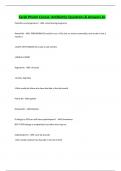Samenvatting
Summary Microbial infection and pathogenesis, antibiotics
- Instelling
- Rijksuniversiteit Groningen (RuG)
Summary about the lecture about microbial infection and pathogenesis, antibiotics including summary for the corresponding literature.
[Meer zien]














